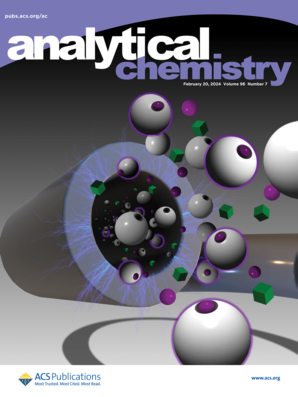Ultrahigh Flow Regulated Discharge Coupling with Targeted Mass Spectrometry Analysis: Real Time Capturing Biomolecules in Exhaled Breath
IF 6.7
1区 化学
Q1 CHEMISTRY, ANALYTICAL
引用次数: 0
Abstract
Online breath analysis is an attractive approach for noninvasive diagnosis of disease and monitoring of human metabolic processes. To date, however, most compounds observed in exhaled breath are volatiles that are not directly associated with blood test results. Here, we proposed an ultrahigh flow regulated discharge (UFD) ionization method that enables online detection of various bioactive breath metabolites and some macromolecules by coupling with mass spectrometry, some of them were commonly observed in blood and body fluids. Through the usage of ultrahigh flow, the corona discharge is transformed into glow discharge in atmospheric pressure, and the mechanism similar to sonic spray may also be involved simultaneously to form a composite ionization manner. Compared to atmospheric pressure chemical ionization (APCI) and electrospray ionization (ESI), UFD exhibited wide coverage and high sample throughput and ionization efficiency for compounds from small volatiles to proteins in different molecular weights (MW). Based on this method, 81 biomolecules can be detected in exhaled breath, including all the 20 common amino acids, nucleosides, tricarboxylic acids, parts of nonprotein amino acids, nucleotides, coenzymes, polyamines, and related derivatives/intermediates. Notably, a total of 63 components were observed for the first time. Moreover, macromolecules also can be detected in exhalation via this method, though these components could not be unambiguously identified due to the limited selectivity. For method validation, the breath homocysteine from five subjects was measured and presented similar trends with blood test results. The online measurement of these biomolecules in human breath showed the possibility of breath tests as an alternative for some blood test items in clinical diagnosis and offers a new approach for real time investigating the metabolic process of nonvolatile bioactive components. Besides, the UFD also provides a new interface for mass spectrometry with a large mass range, wide polarity, high sensitivity, and high throughput.

超高流量调节放电耦合目标质谱分析:实时捕获呼出气体中的生物分子
在线呼吸分析是一种有吸引力的无创诊断疾病和监测人体代谢过程的方法。然而,迄今为止,在呼出气体中观察到的大多数化合物都是挥发物,与血液测试结果没有直接关系。在这里,我们提出了一种超高流量调节放电(UFD)电离方法,该方法可以通过耦合质谱法在线检测各种生物活性呼吸代谢物和一些大分子,其中一些在血液和体液中常见。利用超高流量,将电晕放电在常压下转化为辉光放电,并可同时参与类似声波喷雾的机理,形成复合电离方式。与常压化学电离(APCI)和电喷雾电离(ESI)相比,UFD具有较广的覆盖范围、较高的样品通量和电离效率,可用于从小挥发性化合物到不同分子量(MW)的蛋白质。基于该方法,可在呼出气体中检测81种生物分子,包括所有20种常见氨基酸、核苷、三羧酸、部分非蛋白氨基酸、核苷酸、辅酶、多胺和相关衍生物/中间体。值得注意的是,共有63个组分首次被观测到。此外,通过这种方法也可以在呼出物中检测到大分子,尽管由于选择性有限,这些成分无法明确识别。为了验证方法,测量了五名受试者的呼吸同型半胱氨酸,并呈现出与血液测试结果相似的趋势。人体呼吸中这些生物分子的在线测量显示了呼气测试作为临床诊断中某些血液测试项目的替代方法的可能性,并为实时研究非挥发性生物活性成分的代谢过程提供了一种新的方法。此外,UFD还为质谱分析提供了一个新的接口,具有大质量范围、宽极性、高灵敏度和高通量。
本文章由计算机程序翻译,如有差异,请以英文原文为准。
求助全文
约1分钟内获得全文
求助全文
来源期刊

Analytical Chemistry
化学-分析化学
CiteScore
12.10
自引率
12.20%
发文量
1949
审稿时长
1.4 months
期刊介绍:
Analytical Chemistry, a peer-reviewed research journal, focuses on disseminating new and original knowledge across all branches of analytical chemistry. Fundamental articles may explore general principles of chemical measurement science and need not directly address existing or potential analytical methodology. They can be entirely theoretical or report experimental results. Contributions may cover various phases of analytical operations, including sampling, bioanalysis, electrochemistry, mass spectrometry, microscale and nanoscale systems, environmental analysis, separations, spectroscopy, chemical reactions and selectivity, instrumentation, imaging, surface analysis, and data processing. Papers discussing known analytical methods should present a significant, original application of the method, a notable improvement, or results on an important analyte.
 求助内容:
求助内容: 应助结果提醒方式:
应助结果提醒方式:


